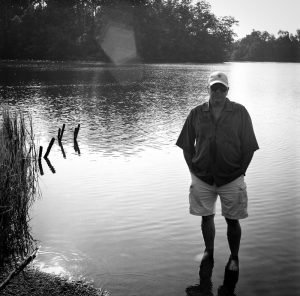+ By Emmy Nicklin + Photos by Marie Machin
 On a muggy, Indian summer night at Coconut Joe’s Bar & Grill in Edgewater, Matt McConville explains the seemingly inexplicable: why he passed up an opportunity to work with a publishing icon 25 years prior. After finishing another set of Neil Young and James Taylor covers, the big-hearted writer/musician/chef/nonprofit founder/school bus driver/philosopher/husband/father drinks his scotch under a moonless, starless sky and reflects. “It’s kind of a funny story,” he says—a line that seems to start all McConville life events.
On a muggy, Indian summer night at Coconut Joe’s Bar & Grill in Edgewater, Matt McConville explains the seemingly inexplicable: why he passed up an opportunity to work with a publishing icon 25 years prior. After finishing another set of Neil Young and James Taylor covers, the big-hearted writer/musician/chef/nonprofit founder/school bus driver/philosopher/husband/father drinks his scotch under a moonless, starless sky and reflects. “It’s kind of a funny story,” he says—a line that seems to start all McConville life events.
Roughly 25 years ago, McConville, with hardly any sailing experience or love for boats—“The thing about boats is that when get on one, you can’t get off,” he says facetiously—found himself as the cook on a 41-foot Bristol bound for the Virgin Islands. Before the trip began, he pitched his idea of writing some gonzoish, nonsailor sailing stories to Playboy editor Reg Potterton, who was intrigued. But Potterton saw more to the pieces and encouraged McConville to pursue a whole book about his misadventures at high seas and the quirky people he met along the way. After finishing it a few years after completing his trip, McConville found that he couldn’t turn the book over to Potterton “I didn’t feel good about it,” he recalls, and started seeing a fictionalized story within it.
 Now more than two decades later, McConville has finally published a two-part novel series. It’s Just the Wind: Kind of a Sailing Story (2015) and Second Wind: Kind of a Trippy Love Story (2016) are loosely based on his travels all those years ago. McConville now jokes: “I’ve been writing this book for 25 years . . . [It’s my] 32-year-old [child] who lives in my basement. And it won’t go away!” Driven by a love of his characters and a deep sense of responsibility to finish the work, McConville persisted. When asked if he regrets not selling the book to the publishing legend, McConville is adamant: “Not one bit. All I have to do is look at my wife and kids,” he says, convinced that his life would not have included them, had he given the initial manuscript to Potterton.
Now more than two decades later, McConville has finally published a two-part novel series. It’s Just the Wind: Kind of a Sailing Story (2015) and Second Wind: Kind of a Trippy Love Story (2016) are loosely based on his travels all those years ago. McConville now jokes: “I’ve been writing this book for 25 years . . . [It’s my] 32-year-old [child] who lives in my basement. And it won’t go away!” Driven by a love of his characters and a deep sense of responsibility to finish the work, McConville persisted. When asked if he regrets not selling the book to the publishing legend, McConville is adamant: “Not one bit. All I have to do is look at my wife and kids,” he says, convinced that his life would not have included them, had he given the initial manuscript to Potterton.
While It’s Just the Wind and Second Wind parallel McConville’s personal experiences, they include many other layers as well. “[I want] to write about significant philosophical, fundamental things,” he says, “but with humor and grace. I usually find that the greatest clarity comes from a good laugh.” His books give us rich, whimsical characters grappling with life’s adventures and wrestling with ghosts and philosophical ruminations. McConville takes another sip of scotch before describing his series as one deeply rooted in the fundamental Hero’s Journey: “[They’re] truly books of ideas . . . He’s trying to find home; he’s trying to get home.”
 Much like his books’ protagonist, McConville had always felt that “home” was a tricky concept. The Pittsburgh native came to Annapolis more than 20 years ago, after stints in Morgantown, Key West, and other far-flung places, and had no intention of staying. “I couldn’t find where the real people were, at first,” he says. But two books, three daughters, and several occupations later, McConville seems to have found his place at long last.
Much like his books’ protagonist, McConville had always felt that “home” was a tricky concept. The Pittsburgh native came to Annapolis more than 20 years ago, after stints in Morgantown, Key West, and other far-flung places, and had no intention of staying. “I couldn’t find where the real people were, at first,” he says. But two books, three daughters, and several occupations later, McConville seems to have found his place at long last.
“My views of Annapolis have changed over the years,” he says on another September night on the back patio at 49 West Coffeehouse, Winebar & Gallery—one of his favorite writing spots. “It’s because of the people I’ve met here, the community we’ve built.” Inevitably, for McConville, who first picked up a guitar at age 12, he found one of the most important parts of that community in the world of musicians. In 2006, he founded the nonprofit Annapolis Musicians Fund for Musicians, Inc. (AMFM), which assists working musicians faced with unexpected hardships (See Up.St.Art Annapolis, “Songs of Support,” Summer 2015, 74–77.). It continues to be one of his proudest accomplishments.
 Surprisingly, McConville didn’t always see himself as an artist: “I was supposed to be the lawyer or the governor or something.” But starting from a very early age, he always seemed to have stories in his head. Drawing inspiration from a litany of artists, everyone from The Beatles to Kurt Vonnegut to Bob Dylan to John Steinbeck, McConville eventually felt compelled to write those stories down. “[I realized] that’s the way I saw the world. I was always trying to find a way to take the pictures in my head and put them into some sort of expression, [whether it’s a book, or music, or food], all the while rejecting the fact that I was doing it, I guess.”
Surprisingly, McConville didn’t always see himself as an artist: “I was supposed to be the lawyer or the governor or something.” But starting from a very early age, he always seemed to have stories in his head. Drawing inspiration from a litany of artists, everyone from The Beatles to Kurt Vonnegut to Bob Dylan to John Steinbeck, McConville eventually felt compelled to write those stories down. “[I realized] that’s the way I saw the world. I was always trying to find a way to take the pictures in my head and put them into some sort of expression, [whether it’s a book, or music, or food], all the while rejecting the fact that I was doing it, I guess.”
These days, when he’s not driving a school bus, making his daughters’ lunches, playing music, or managing AMFM, McConville writes. “It’s part of the many things that I love. I see things that break my heart—not in a bad way, but in a beautiful way . . . writing helps ease that, the way that music does. I think most artists are trying to find ways to ease our broken hearts because our hearts break in so many ways. It’s not just the horror of life, it’s the beauty of life. It’s all of it.” █











